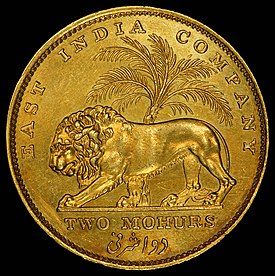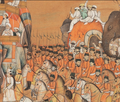Akbar II
This article needs additional citations for verification. (May 2017) |
| Akbar II | ||||||||||||||||||||
|---|---|---|---|---|---|---|---|---|---|---|---|---|---|---|---|---|---|---|---|---|
Maratha Confederacy | ||||||||||||||||||||
| Died | 28 September 1837 (aged 77) Delhi, Mughal Empire | |||||||||||||||||||
| Burial | Moti Masjid, Delhi, India | |||||||||||||||||||
| Spouse | Mumtaz Mahal[1] Anwar Mahal[2] Lal Bai[3] Selaa'h-un-Nissa Gumani Khanum | |||||||||||||||||||
| Issue | 14 sons including
Mirza Firuz Bakht 8 daughters | |||||||||||||||||||
Akbar II (Persian pronunciation: Akbar had little de facto power due to the increasing Ram Mohan Roy as an ambassador to Britain and gave him the title of Raja. During his regime, in 1835, the East India Company discontinued calling itself subject of the Mughal Emperor and issuing coins in his name. The Persian lines in the company's coins to this effect were deleted.
Akbar II is credited with starting the Hindu–Muslim unity festival Phool Walon Ki Sair.[5][6] His grave lies next to the dargah of 13th-century Sufi saint Qutbuddin Bakhtiar Kaki at Mehrauli. Early life Prince Mirza Akbar was born on 22 April 1760 to Emperor Shah Jahan IV fled, Mirza Akbar was titular Emperor with the title of Akbar Shah II, and was to remain acting emperor even after the reinstatement of his father Shah Alam II , till January 1789.
Reign  Emperor Akbar II presided over an empire titularly large but in effect limited to the Red Fort in Delhi alone. The cultural life of Delhi as a whole flourished during his reign. However, his attitude towards East India Company officials, especially Lord Hastings, to whom he refused to grant an audience on terms other than those of subject and sovereign, although honourable to him, increasingly frustrated the British, who regarded him as merely their pensioner. The British therefore reduced his titular authority to 'King of Delhi' in 1835 and the East India Company ceased to act as the mere lieutenants of the Mughal Empire as they did from 1803 to 1835. Simultaneously they replaced Persian text with English text on the company's coins, which no longer carried the emperor's name. The British encouraged the Nawab of Oudh and the Nizam of Hyderabad to take royal titles in order to further diminish the Emperor's status and influence. Out of deference, the Nizam did not, but the Nawab of Awadh did so.
He is also known to have bestowed the title Nawab upon the Nawab of Jaora .
Akbar II appointed the Bengali reformer Ram Mohan Roy, to appeal against his treatment by the East India Company, conferring on him the title of Raja. Ram Mohan Roy then visited England, as the Mughal envoy to the Court of St. James. Ram Mohan Roy submitted a well-argued memorial on behalf of the Mughal ruler, but to no avail. The grave of Akbar II lies within a marble enclosure adjoined to the Shah Alam I) and Shah Alam II are also buried here.[7]
Descendants After the mutiny, cousins of Burma .
See also
References
Bibliography
| ||||||||||||||||||||





